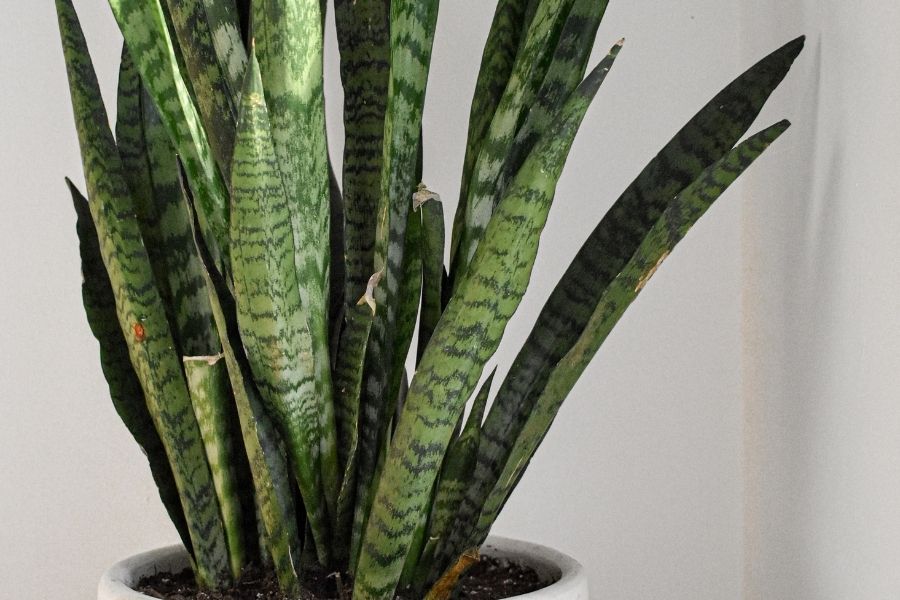
Broken or damaged snake plant (also known as Sansevieria) leaves can be unsightly and in some cases can even reduce your plant's overall health. The growing environment could be to blame, or a plant disease might be your problem. There are many reasons that this might be happening to your snake plant.
Broken or damaged snake plant leaves can be pruned without reducing the plant's overall health. You can also cut away only the damaged parts, use the leaves for propagation, or don't do anything about the damage and let the plant heal itself.
If you are not sure how to treat your broken snake plant leaves, read on for more information!
Contents
- What to do With Damaged (or Broken) Snake Plant Leaves
- 1. Don't do anything and let the plant heal itself
- 2. Only cut away the damaged parts
- 3. Cut away the entire damaged leaves
- 4. Use the broken or damaged leaves for propagation
- Will broken snake plant leaves grow back?
- Prevent the leaves from any more damage
- Other problems that can cause damage to the leaves
- Root Rot
- Mealybugs
- Spider Mites
What to do With Damaged (or Broken) Snake Plant Leaves
Below are 4 things you can do with damaged or broken snake plant leaves.
1. Don't do anything and let the plant heal itself
You can cut away the dead or damaged leaves if you are tired of looking at them but that is not necessary. The plant will heal itself over time and the damaged or broken leaves will die and fall off the plant.
However, if the snake plant has a lot of damage, this natural healing process can actually take a long time (months).
If you don't want to look at damaged or broken snake plant leaves all the time, you can use one of the methods below.
Also if the damage on the leaves of the Sanseveria (snake plant) is caused by a pest or a disease, it's best to trim away the damaged leaves. By trimming away the affected leaves, you can prevent the pest or disease from spreading further.
2. Only cut away the damaged parts
Snake plant leaves that are damaged are unsightly but they might also cause more stress to the plant. Trimming away the damaged parts can be a good way to make your plant look better as well as encourage your plant to grow new and healthier leaves.
3. Cut away the entire damaged leaves
Trimming can be a necessary part of the process of caring for your snake plant even when it is healthy. This will control the size of the plant. When the plant isn’t healthy, trimming away dead leaves can improve its overall health.
Prune around the edge of the plant first. Use a sharp knife and cut close to the soil line. Hold the leaves at the top and apply a little downward pressure with a very sharp blade or knife. Hold the knife parallel to the soil for the easiest cutting process.
The leaves can be tough, so you need to use firm downward pressure to cut each leaf. Make sure to remove all of the damaged leaves working from the outside to the centre of the plant.
You do not want to cut into the area at the middle of the leaf, as this can cause further moisture or other damage to the plant.
4. Use the broken or damaged leaves for propagation
Snake plants are very easy to propagate which makes them really fun. You can easily make more of these lovely plants with ease once you know how to do this simple process. These are some of the easiest plants to propagate, even with wilted leaves that have been trimmed off.
How to propagate your snake plant:
Step 1: Make sure the leaves are not infected with a disease or a pest. Look for unusual colors, mushy parts, and tiny insects. You only want to propagate a healthy snake plant.
Wilted leaves can be propagated, however, pest or disease-infected leaves are not ideal to propagate.
Step2: Choose a tall container that is tall enough to hold a leaf from the plant. Select a healthy leaf that is clean and fresh if possible. It is best to use one that has just been cut off the parent plant. Put the cut end of the lead in a small amount of water that just covers the bottom of the leaf.
Step 3: Make sure that the leaf stays straight in the pot as it is allowed to get started growing. You want to provide the right kind of light and warmth for the cutting. If you have used peat or moss, you will have better luck keeping the leaf upright in the pot.
Step 4: The plant should be rooted and ready to take off growing after about two weeks! You will want to give it a few weeks to get established before giving it to a friend or family member.
If you are propagating for your own use, you can create quite a nice little farm of snake plants from your trimmings!
If you like this kind of content, check out: Philodendron Golden Goddess Care: The Ultimate Growers’ Guide.
Got your Click & Grow Smart Garden Today
Use code UNICAPLANTS10 for a 10% discount, click here.
Will broken snake plant leaves grow back?
Broken leaves will grow back so long as your plant is not damaged by incorrect potting techniques or a plant disease that has not been resolved.
You should wait about a month to see new growth. Remember that your plant will grow the most in spring and summer, so if you have trimmed your plant in winter, it might take a bit for new leaves to show up.
You can fertilize with the proper fertilizer (only during spring and summer) if you want to increase your plant's chances to set new growth speedily.
Make sure not to use too much fertilizer because that will hurt the plant and burn the leaves.
Here are some care tips to increase the plant's growth rate so that it can heal faster after the damage has been done to the leaves.
- Plant in a pot with a drainage hole in the bottom to prevent standing water from collecting near the roots.
- Use a well-draining potting mix like a cactus mix (snake plants do not like being too wet).
- Don’t bury the roots too deep. Your plant should not be buried well above the root ball or it could be damaged by excess moisture.
- Only water the snake plant if the top 1 inch of the soil is dry to the touch.
- Water less in the winter when the plant is not actively growing.
- This plant does not need a lot of water, so you need to make sure that you track the wetness of the soil and maintain a damp but not soaked soil condition when watering.
- Snake plants thrive in temperate climates, so when you plant outside, be aware of your hardiness zone. Snake plants are only winter hardy in zones 9 to 11.
- Snake plants tend to grow rapidly and require dividing at least once a year to prevent them from becoming rootbound (repot every 2-5 years).
Prevent the leaves from any more damage
You should always make sure that you have provided the right growing situation for your snake plant. Snake plants like bright and indirect light and they can only tolerate a little bit of direct sunlight. Shady corner might be too dark for your snake plant.
Make sure that you diagnose any plant diseases correctly and treat them carefully. You can trim your snake plant and take all of the right actions to give it the right growing conditions, but it will not thrive if it is sick with a disease.
Be aware of pets or children that might be damaging your snake plant as well. If your snake plant is easily accessible, it might be damaged by your pet running into it or climbing on it.
You need to be sure that your snake plant is not being knocked over or suffering other damage due to its location or surroundings.
Other problems that can cause damage to the leaves
Snake plants are very hard to kill but they can be susceptible to certain plant diseases. The most common of these are related to incorrect care of the snake plant.
Below are three of the most common diseases and pests that can cause damage to the leaves of your snake plant.
Root Rot
This is a common snake plant ailment due to overwatering the plant. You will see browning or dying leaves and the roots might be squishy or slimy to the touch.
Always remove a plant with root rot from the pot it is in and replant in fresh soil. Rinse the roots before replanting and remove all rotted roots and leaves.
Mealybugs
These nasty little bugs are a common houseplant pest. These insects can show up as white spots or you might see the bugs themselves.
Rinse off the plant with a garden hose and then wipe off any remaining bugs that you can see. You might want to treat it with a gentle insecticide (check out my shop for a great organic pesticide)
Spider Mites
Another common snake plant pest is spider mites. These bugs create white, cobweb-like detritus on the leaves and stems of affected plants.
You will not be able to miss their presence and your plant might start to wilt and look yellow. Treat these invaders in the same way as you would treat mealy bugs.
Always remember that damaged or broken leaves are probably only a symptom of another condition that is leading to a lack of plant health.
You need to rule out any of these common houseplant ailments as well as improper potting soil and other considerations like a lack of light when you are diagnosing the reason for your snake plant’s broken leaves.
If you like this kind of content, check out: The 17 Best Plants to Place on Top of a Fridge

